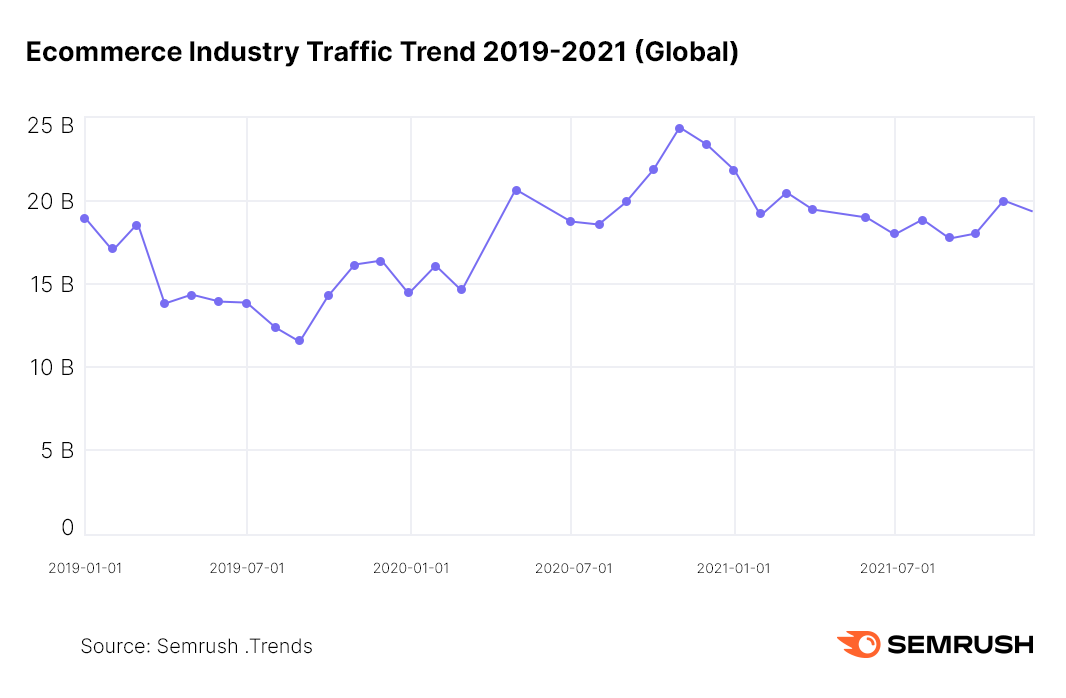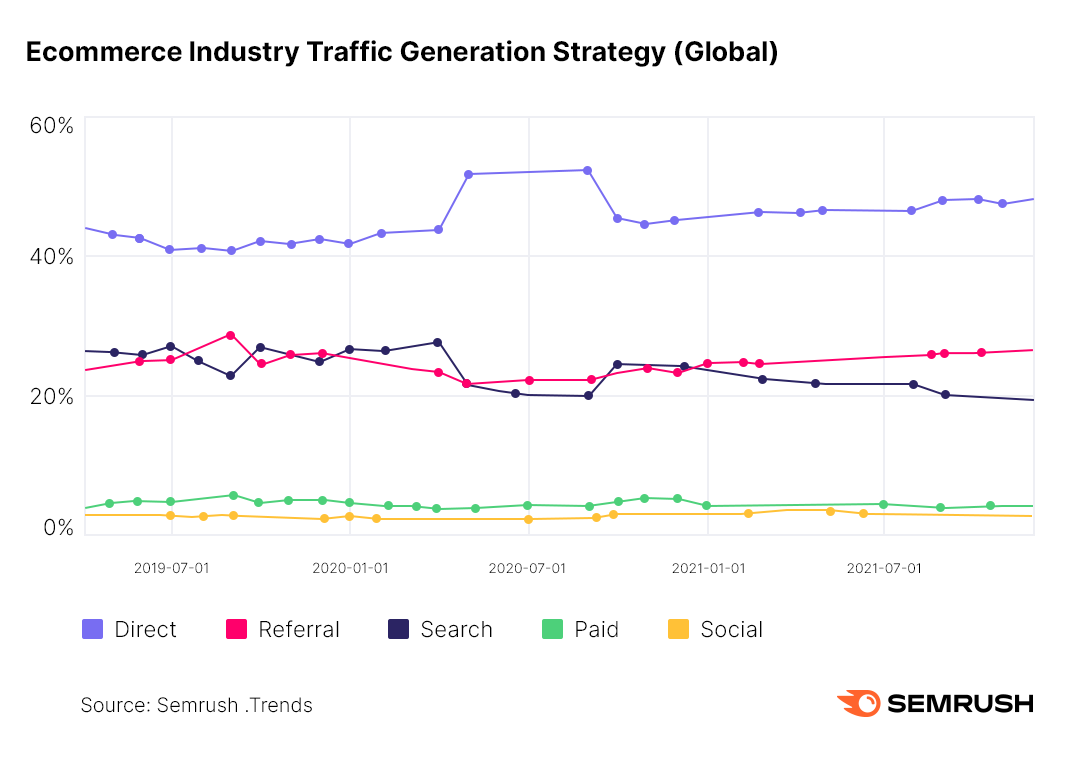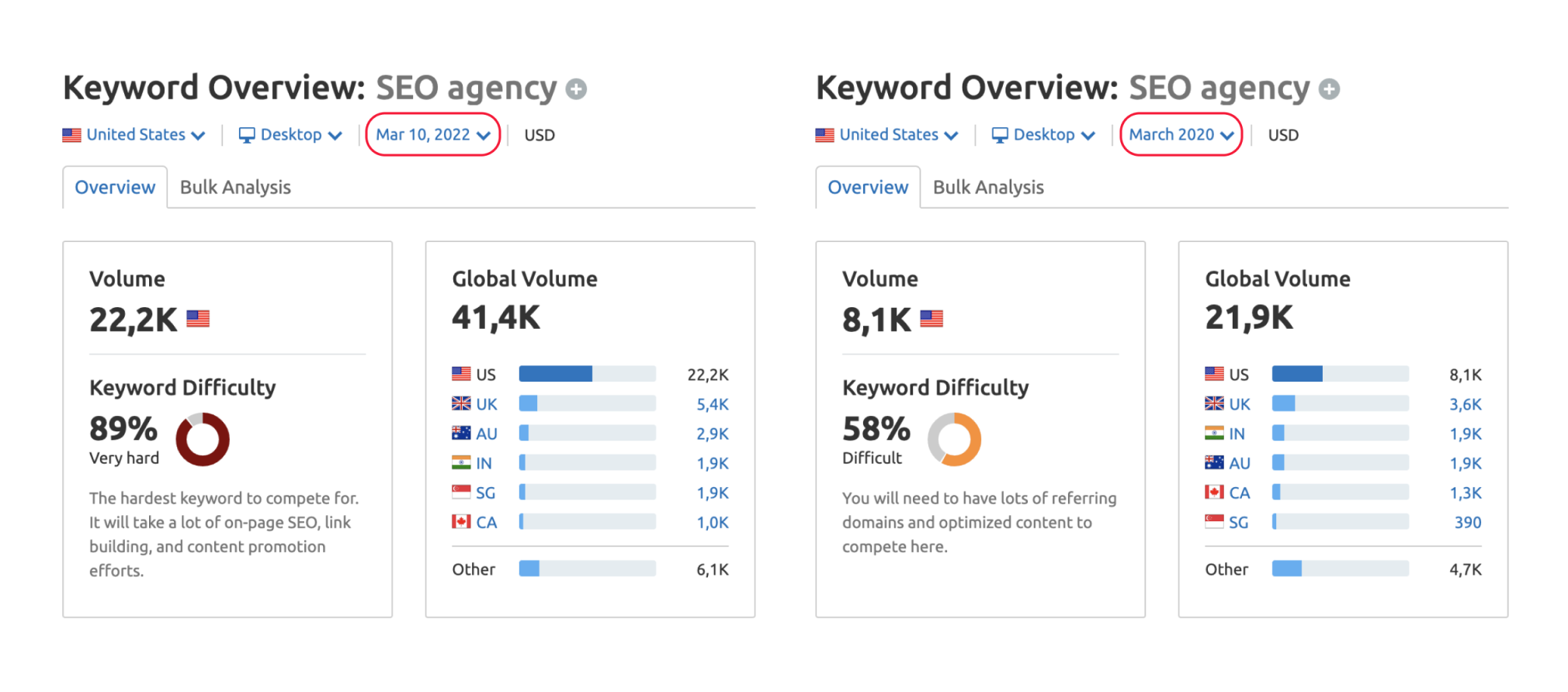Looking to the future, there’s no denying ecommerce will play a major role in business. Beginning in 2020, the COVID-19 pandemic accelerated an already growing ecommerce market by driving shoppers online. But as we adjust to a new world with covid, many questions remain.
Will online sales continue to rise at a significant rate? Looking forward, how much should businesses focus on ecommerce? And how will marketing change in light of shifting marketplaces?
Our new report, Shaping Your Ecommerce Strategy in 2022: Key Industry Trends, provides some answers to these questions. Though ecommerce growth rates have slowed by 2% over the past two years, the value of the industry globally, it appears ecommerce is here to stay.

Looking forward, businesses need to strategize to meet the demands of a complex market. A single-pronged strategy focused solely on brick-and-mortar sales or solely on ecommerce won’t be sufficient moving into the future. To realize their maximum potential, most businesses need a nuanced strategy.
In looking toward 2022 and beyond, we reached out to some of the ecommerce industry's top thought leaders. In this article, you’ll hear from five ecommerce experts from around the globe:
Kevin Indig—Director of SEO at Shopify Himani Kankaria—Founder of Missive Digital Kunle Campbell—Co-Founder of Octillion Capital Partners Aleyda Solís—International SEO Consultant & Founder at Orainti Guido Pedrelli—Multichannel Marketing Manager at Walmart MarketplaceOur broad ranging conversations led to a bounty of insights and strategies related to launching ecommerce businesses, entering new markets, and increasing traffic and sales.
Entering Ecommerce in 2022: Marketplace vs. Website Sales
Regardless of your current relationship with ecommerce, now is the time to begin thinking about online sales. All of our experts agreed that entering the online marketplace is a must. “With the ease of getting started online,” Pedrelli says. “Everyone should have a presence.”
Being online not only broadens your available market, but also allows you to gain insights about your customers that aren’t available in a brick-and-mortar setting. And data collected directly from customers will be increasingly important as we look toward the future of marketing—more on this below.
But even if your desire to enter the ecommerce market is clear, you may still be wondering, what’s better? An online store on your business’s website, or a third-party marketplace?
Our experts suggest the best option is likely a combination of the two. Kankaria says, “Third party marketplaces are a great way to land early customers. Then, you establish a website with all of your products to engage returning customers.” With a strategy that combines both, you can engage customers at each stage in their journey with your business.
Along with connecting you to new customers, third-party platforms can also allow you to test marketplace receptivity to your products. “With platforms like eBay, Etsy, and even Amazon,” Solís suggests. “You can test the waters to learn about the market, obtain feedback, investigate and test logistics, investigate selling prices.” This kind of early testing can help you determine what products are hot and provide marketing ideas.
For boutique products, having your own website often makes the most sense. As Pedrelli says, your own website “allows you to tell your own story, giving you full control over how you present and sell your product.” Some of this control is lost when it comes to third party platforms, which exert control over the entire sales process. “Third party platforms don’t need you,” Solís adds when speaking about the challenges of third-party marketplaces. “They can freely change their conditions, their prices, or even block your product for some reason, and it can really impact your business.”
Ultimately, the question isn’t whether you should choose one over the other, but making sure that you’re taking a brand-first approach and creating continuity between platforms. Campbell notes, “Selling long term is about engaging. You grab the attention of an audience. You engage with them, they purchase with you, and you hope to continue to engage with them so the purchase continues long term.”
So from a third party platform, you need to make sure customers can find their way back to your site. “Make sure that you leave trails,” Campbell continues. “Digital trails, to get back to your website so you can essentially directly engage with these people.”
Regardless of the entry point, it seems everyone is in agreement: direct engagement with your audience is always best.
Key Takeaways
Ecommerce not only broadens the available market, it allows you to capture necessary data that will help your business grow. A combination of a business website and third party marketplaces can be a winning ecommerce strategy that allows you to meet your customers at every stage of their journey. Your own website can allow you to tell your own story, which can be beneficial for boutique products. When using third party platforms, leave trails that allow customers to find their way back to your business’s website.An Ecommerce Strategy for Expanding Your Business in 2022 and Beyond
Whether you’re starting from scratch or expanding an established business, new markets are key. Ecommerce removes many barriers companies have faced in the past, though expansion never comes without challenges.
As a starting place, Campbell suggests conducting some testing. “If you have the capacity,” Campbell says. “Start shipping worldwide.” An influx in orders from a particular country can indicate it’s time to double down in that location. Starting small in this way can help you avoid large investments that don’t offer significant returns.

Our experts also spoke about the importance and pitfalls of localization. When looking to markets in different countries, cultural norms and values can impact the sales process. Indig offered Germany and Japan as examples. “Everyone in the US has a credit card,” he says. “But in Germany and Japan not everyone feels comfortable entering credit card information online.” This kind of demographic distinctions can have a big impact on your business if you don’t offer options aligned with customer preferences.
When it comes to new market analysis, our guests suggest starting small and from within. “You want to talk to people on the ground,” Indig says. “It will give you a much better idea of what they really care about and what their preferences are.” Along similar lines, Kankaria suggested companies “hire microlevel influences who are locally present, but cost effective.”
On the topic of scaling, the experts seemed most focused on supply chains. “If you want to scale big and fast,” Indig says. “Make sure you have a local supplier and a backup that can jump in if your main supplier goes down.” People turn to ecommerce because they like the convenience. Availability of products and the speed with which you can deliver them are key features of any ecommerce business.
Key Takeaways
Test new markets before making large investments. Start shipping worldwide if possible and gauge demand. Consider cultural norms and values before entering new markets. You can start broad by grouping countries by region, but do on the ground market research starting from within as you decide on locations. Start small and from within when it comes to launching products and marketing them. Micro-level influencers can be a great place to start.A Cookieless Future: Ecommerce Marketing Strategy in 2022 and Beyond
Traditionally, the ecommerce industry has benefitted from targeted marketing made possible by third-party data providers. But with Google and other big names in data planning to phase out third-party cookies this year, many marketers are wondering what the future of digital marketing will look like.
In this post-cookie digital world, one-to-one tracking will no longer be possible. Instead data will be anonymized and grouped, which will allow for some level of targeting, though, as Indig says, “the idea of hyper targeting is going away in the future.”
The experts we spoke with were aligned in their predictions of how this will impact marketing as a whole. “Digital marketing will still be possible,” Pedrelli says. “But it will be more like traditional marketing, meaning you’ll have a broader target audience, which will require higher investments.” Indig shares this sentiment. “Marketing will look a little bit more like it did before the internet,” he says. “Where you didn’t have perfect proofing and targeting.”
This sea change in marketing methods will likely shift the ways businesses interact with customers and the channels they use to connect. Most of the experts stressed the importance of first-party and zero-party data moving toward the future.
“Businesses should focus on converting people into environments they control,” Indig suggests, which allows for direct relationships with customers that will limit reliance on targeted ads. Campbell shared a similar opinion when he spoke to the idea of “converting customers from unknown to known.” Without endless streams of third-party data, businesses will need to develop closer relationships with customers.
In terms of marketing strategies, Campbell says, “it goes back to knowing who you are as a brand, what you stand for, and letting that define who you’re speaking to. Then, you connect with the spaces where those people hang out with trails leading back to your own website where you can take zero-party data.”
Along with understanding your own brand, the importance of brand awareness among consumers is crucial. Our recent study showed direct traffic was a huge asset for top ecommerce brands, and our experts suggest a strong focus on brand awareness and SEO could give businesses an edge.

On the subject of brand awareness, our experts were aligned on its importance, and influencer marketing came up several times during our interviews. “Without influencer or word-of-mouth marketing,” Kankaria says. “People hardly buy anything online.” Even third-party marketplaces include reviews that people read before making purchases.
Practically speaking, Indig suggests putting the largest portion of your budget toward influencer marketing. To make it more tangible, with a $10,000 marketing budget, he suggests “putting $5,000 in the hands of influencers…$3,000 on podcast advertisements, and the other $2,000 to Instagram and TikTok ad campaigns.”
The other focus of our discussions centered on SEO. Pedrelli says it’s already gaining additional interest as companies begin looking beyond third party data. “The number of searches for SEO agencies or SEO jobs are increasing,” he says. “Companies have seen the importance of SEO and the ROI it can bring over the long term.” Without targeted marketing, people will likely turn to search engines to seek out the products they want, and making sure that your products are front and center will be key.

Several of our experts furthered this idea by speaking to the power of bringing SEO and brand awareness together. Kankaria says, “Brand awareness is the easiest way to win business on Google or any search engine. We’re seeing an increase in branded terms. The more customers remember you, the more they will search for you on search engines, and then they will think of buying from you.”
Campbell offered a similar idea through the analogy of a soccer team. “A midfielder sets the tone for a striker,” he says. “Channels like Instagram or TikTok are like the midfielder. They set the brand awareness. And then channels like SMS, email, and Google close and get the goals in for you like the striker.” In this way, your marketing channels are working together to guide your customers seamlessly through your sales funnel.
Key Takeaways:
Hyper-targeting in marketing is going away. Digital marketing in the future will likely resemble traditional marketing with broader target audiences. Before deciding on a marketing strategy, examine your brand. Understanding who you are as a business will help you choose the right marketing channels. Brand awareness and SEO are going to become more and more important in 2022 and beyond. Consider how different aspects of your branding and marketing function together to drive sales.Final Thoughts Looking Toward the Future
When taken together, the insights provided by our thought leaders make it clear that the future of business exists in the relationship between digital and in-person experiences. Looking forward, it will be crucial to consider these business modalities not as distinct aspects, but as part of a whole. An integrated experience that meets the needs of customers across the board is the future of business.
Innovative SEO services
SEO is a patience game; no secret there. We`ll work with you to develop a Search strategy focused on producing increased traffic rankings in as early as 3-months.
A proven Allinclusive. SEO services for measuring, executing, and optimizing for Search Engine success. We say what we do and do what we say.
Our company as Semrush Agency Partner has designed a search engine optimization service that is both ethical and result-driven. We use the latest tools, strategies, and trends to help you move up in the search engines for the right keywords to get noticed by the right audience.
Today, you can schedule a Discovery call with us about your company needs.
Source:





